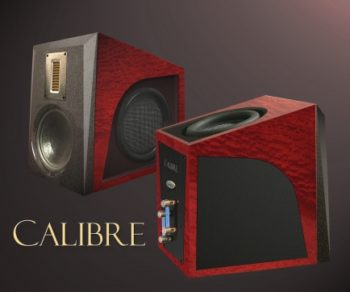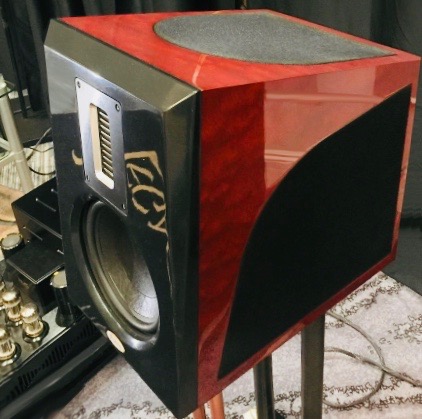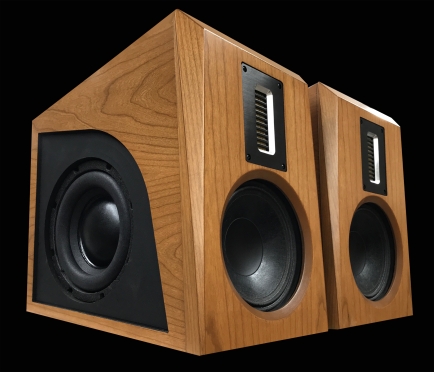
In Part 1 of this review, I gave the description and company profile, so now I’m going to get on with describing how the Calibre speakers sounded in my reference system. I tried this speaker with my Pass Labs XA30.8 (reviewed for Dagogo here), the First Watt SIT3, the LTA Ultralinear and the Triangle Arts Reference Tube Monoblock Amplifiers (review coming soon). While they sounded incredible with the Triangle Arts amps, I ultimately decided to do the review with the Pass Labs XA30.8 amp because it best fits the price I think someone would be willing to pay for an amp to use with the Calibres, and in many ways it was the best choice amp for these speakers.
Setup
When I moved the speakers downstairs and hooked them up to my reference system, I was able to pull them out into the room. They sounded their best about seven feet apart, which put them a little over three feet from the side walls. I ended up with them five feet from the rear wall. Positioned like this, they produce incredibly powerful bass without any overhang. If you prefer a little fuller bass, you can move them back about nine inches without sacrificing much in imaging and soundstaging. They also had fuller bass with the Triangle Arts tube amps.
Listening
I want to start with the sound of the top-end and upper-midrange. I continue to be impressed with the current implementations of the AMT tweeter. The 4-inch AMT tweeter was very transparent and detailed without being edgy or harsh. The superb top-end has some great benefits. To start with, it enables the treble of instruments to sound very beautiful with natural air around strings and horns. It has been my experience that a well-extended top-end also helps with the spatial cues of instruments and voices.
The Calibres produced the kind of imaging and soundstage specificity I expect from a world-class mini-monitor but with a wonderfully voluptuous sound. Nearly ten years ago, I reviewed the almost $20,000 Ayra C1s. They had an ability to produce a reach-out-and-touch-me soundstage like I had never heard before or since in my house. The Calibres are a really close second to what I remember from the Ayra’s, and the Calibres do everything else that has to do with better enjoying the music.
The Calibre speakers also have good inner detail and are transparent but, audiophile things like sound staging, inner detail and transparency, as good as they are, aren’t what these speakers are all about. No, these speakers are about experiencing the music and fun. They will rock better than most floor-standing speakers. Truth is, the only speakers I have had in my house that rock like the Calibres were all over 98dB efficient.
Even though they are only 90dB efficient and are multi-driver speakers, they have dynamics, scale, and slam that I was thrilled to hear. I know as reviewers we often say that certain monitors sound big, but the Calibres really do; they sound big and very powerful. Without a doubt, the main contributors to this power are the bass power and the quality of these speakers. Note, I did not say for their size; the bass is outstanding for speaker of any size.
I think we have to admit that audiophiles have different tastes, and nowhere is this truer than it is about bass. There are those who love speakers that have cabinets that do not resonate and value fast, tight bass with real slam. Then, there are those who value fuller bass with plenty of decay and bloom. For less that $12,000, the Calibres come closer than any speaker I have heard to producing bass that will please both groups.

The bottom-end was quick, fast, nimble and very accurate. These qualities allowed the bass transients in the lower range to have details seldom heard other than in live music. Their leading edge was as good as I have heard from any speaker, and they have wonderful bloom, air and decay when playing bass instruments.
In Part 1 of this review, I said, “When listening to Cheryl Bentyne and Rob Wasserman on ‘Angel Eyes,’ Bentyne’s voice went from very soft to very loud without a hint of edginess or hardness. Wasserman’s bass was just a tad fat, but I expect that has more to do with the placement of the speakers in my video/digital system than with the Calibres.” Well, setting them up in my reference system with the Pass Labs XA30.8 was a total revelation. Wasserman’s bass sounded lifelike with quick fingering, beautiful bowing and wonderful tone. It was not only the bass that sounded better. Cheryl Bentyne’s voice on “Angel Eyes” was as dynamic and voluptuous as I have ever heard it from a multi-driver speaker with a crossover, which covers probably 99% of all commercially available speakers.
After listening to Wasserman’s Duets album, something drew me to get out an old LP I love but hadn’t listened to in a while, Arturo Delmoni’s Songs My Mother Taught Me on the North Star Records’ label. It was released in 1986, and it is an uncannily beautiful and romantic recording of classical music played on a violin and accompanied by piano. Listening to this LP with the Calibre speakers, I was impressed by the beautiful tonal colors I heard.
As I have mentioned before, one of my all-time favorite audio writers and reviewers is Art Dudley; I still have all my issues of his now-defunct magazine, Listener. He sometimes refers to a piece of equipment as sounding “juicy.” I think with the Calibres, this is a better word to describe how violins, saxophones, guitars and many other instruments sounded than saying they had a sweet sound. They play music with an amazingly organic and tuneful sound. Another LP that really shows off these musical qualities is an MA recording Sera una Nache La Segunda. This album allows you to hear these beautiful qualities on a broader range of instruments and voices. The female vocal is simply luscious, and the woodwinds, guitars and drums all sound beautiful and very much like real voices and instrument sound.

Next, I put on Miles Davis’ Someday My Prince Will Come, and I listen to both the mono original and the Analogue Productions 45-RPM version. Miles’ trumpet is portrayed with a nice and very realistic bite while maintaining that full juicy sound. Jimmy Cobb’s cymbals had a nice attack, really nice tonal color and beautiful shimmer. The scale of the instruments and the power of the performance was amazingly life-size and lifelike.
Are the Calibres perfect speakers? Of course not; compared to the Teresonic Magus compact speaker, the Calibres are slightly less transparent, the micro-dynamics are not as quick and they aren’t as lively sounding. The biggest difference, as you would expect, is that even a great three-way isn’t as coherent as a crossover-less speaker. The Magus is an $8,000, 100dB efficient, single-driver speaker. This doesn’t make the Magus necessarily the better speaker. I would guess that about 75 percent of the audiophile I know would prefer the Calibres, while they do have a few weaknesses that are only apparent by comparison, their many strengths are obvious.
Conclusion
Legacy Audio Calibre Speakers are simply outstanding and most of all, they are so much fun to listen to! In a day when you can go to audio shows and find several small speakers that cost in the five figures. Still, $5,500 is a lot for a stand-mounted speaker, but consider what you get:
- two 8-inch mass-loaded acoustic radiators mounted on opposing sides to eliminate port noise and cancel resonance
- a wonderful 4-inch AMT tweeter
- a pair of speakers that weigh in at 50 pounds each
- one of the most beautiful small speakers I have ever seen
More importantly, however, you get an extremely musically involving and satisfying speaker. It’s not just a great speaker for its size, it’s a stunningly great speaker and, if not a great bargain, it is an incredible value. I could not recommend a speaker more highly for a two-channel stereo system or a home theater system.
Specifications
System Type: 3 driver, 3 way
Tweeter: 4″ AMT
Midrange: 7.5″ accordion edge with 6 lb magnetic structure
Bass: 8″ Extended Throw
Sub-Bass Radiator: Dual 8″ mass loaded pneumatic
Low-Frequency Alignment: 6th order mass loaded radiator
Binding Posts/Inputs: 2 Pair binding posts for Treble and Bass
Internal Amplification: available with 500 watts internal ICEpower in the XD version
Recommended Amplification: 45-400w
Frequency Response (+/-2dB, Hz): 38-30k
Impedance: 4 ohm
Sensitivity: 90.5dB (2.83V @ 1m)
Crossover (Hz): 200, 2.5k
Dimensions HxWxD (inches): 16.25 x 10 x 15.25
Cabinet Weight (each): 50 Ibs
Shipping Weight (each): 56 Ibs
Price: $5,500

Better than B&W 805 D3?
What other 2way speakers have you heard recently?
Yes, I’m very familiar with the B&W 805Ds, as well as the Trenner & Friedl ART, the Fritz Carrera Rev 7 BE, the Fritz Carbon SE, the Fritz Accuton 6, the latest version of the Audience ClairAudient 1+1s, KEF LS-50, the Studio Electric M4s and more. The Calibre is head and shoulders above them all in most musical areas. If you are mostly into midrange, imaging, transparency, imaging, soundstage, and can live with the volume less than rock levels then you might prefer the Audience speakers. If you need more volume but still a very refined speaker then maybe you would like the SE M4s.
Still, I would prefer the Legacy Audio Calibre overall myself.
I have the Sit-3 amp…..how does that match up with the Calibres?
Philip, thank you so much for reading our site. I feel the Calibres need a little more power to really sing. The Pass Labs XA30.8 for example.
Thanks,
Jack
Jack
From what you’re saying Calibres are ideal for electronic music with slam and bass out of this world right?
Also, do they sound full (with full bass and scale) or lifeless/flat at low volumes?
Have you ever heard any of Phil Jones creations i.e. Platinum Solo/Duo and AAD 2001/2002? Do you think Calibres are even better and with bigger slam ?
thanks
Hello,
I was wondering if you had an overall opinion of the Passive vs Active Calibre? Also, would 3 Calibre in a L C R configuration make sense with a Legacy Foundation subwoofer make sense?
Thank You
Larry, I have spent hundreds of hours with Legacy speakers. The active version you are referring to is called Caliber XD. Here, each cabinet contains one 500 watt ICE class-D module which can be configured to either power the entire speaker or merely drive the bass section provided you also have a digital crossover from Legacy Audio that is programmed for such set-up.
The 3 Calibre in a L C R configuration with a bass tower is definitely a posibility but you will definitely need a Wavelet crossover/room-correction device from Legacy to implement it.
Have you considered the Focus SE? When paired with a decent powerful solid state amp (old Levinsons, krells, Codas and Pass Labs… ), the Focus bass is simply norm-setting. (Unfortunately Legacy speakers and tube amplification are seldom happy together) The mids and highs are too flawless. If the chance avails, you got to audition Focos SE!!!